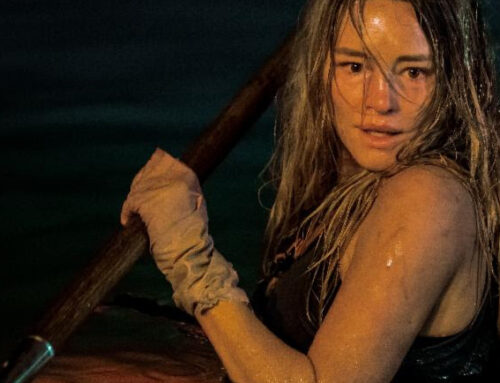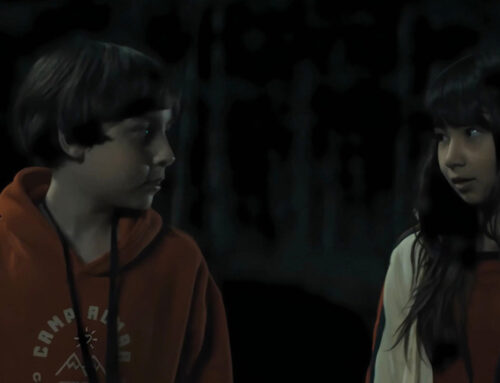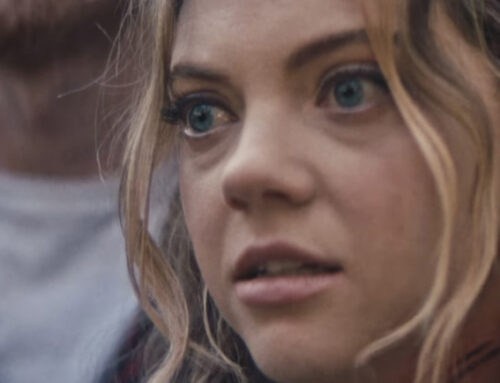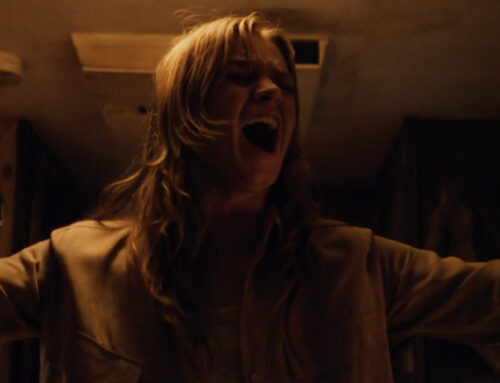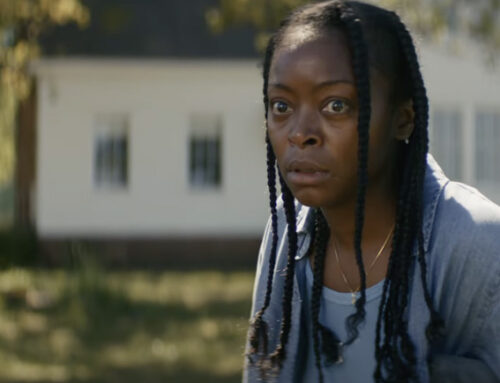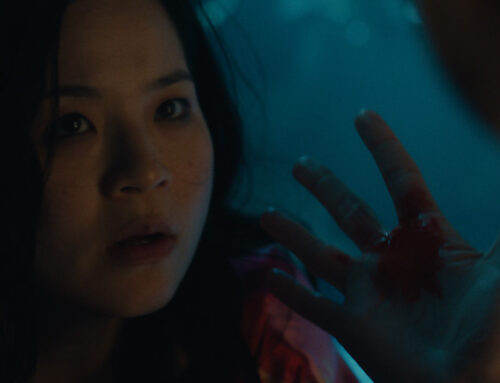Earlier this summer, Shudder delighted horror fans with the announcement that they would be kicking off their “61 Days of Halloween” celebration beginning September 1st. The line-up included original series such as 101 Scariest Horror Movie Moments of All Time, Queer for Fear: A History of Queer Horror, and exclusive films such as Who Invited Them, Saloum, Flux Gourmet, Speak No Evil, Deadstream and the Rebecca Hall starrer Resurrection. Another original title worth mentioning is Christopher Hatton’s Raven’s Hollow starring William Moseley (The Chronicles of Narnia series) as Edgar Allan Poe.
In case you aren’t familiar with the film, Raven’s Hollow is set in Autumn, 1830. West Point military Cadet Edgar Allan Poe and four other cadets on a training exercise in upstate New York come upon a man eviscerated on a bizarre wooden rack. His dying words direct them to a forgotten community, which they believe is guarding sinister secrets. Enthralled by the Innkeeper’s beautiful and mysterious daughter Charlotte and fuelled by the town resident’s refusal to speak to the murder, Poe determines to uncover the truth. Risking his life and more, Poe ultimately comes face to face with the terror that will haunt him forever.
Adding to the horror tale is the original score by composer Robert Ellis-Geiger, whom successfully combines both acoustic and electronic instruments to create haunting melodies. Some of Robert’s other credits include Election 2, After This Our Exile and Golden Gate Girls to name a few. In the below exclusive interview, we spoke to Robert about his creative process for Raven’s Hollow and much more.
Raven’s Hollow is available now on Shudder. Robert’s score can be found here: https://music.apple.com/us/album/ravens-hollow-vol-1-original-motion-picture-soundtrack/1646235115
-How did you first get involved with Raven’s Hollow?
I was introduced to director Christopher Hatton in Singapore in July of 2016 by his close friend and fellow filmmaker Gisli Snaer. Chris, Gisli and myself met up over a few beers and discussed movies, music and life in general. We kept in touch and this eventually led to me working on Raven’s Hollow.
-How would you describe your score for the film?
The score is a sonic tapestry of music and soundscape design.
Always on edge, meaning, when a theme is heard (mostly on wind instruments) the pitch is either subtly varying, or a supporting part below or above is having its pitch altered over time.
The score is consistently battling between dissonance and consonance, tension and release.
The music ranges from traditional harmonic composition, improvisation based on sketches made at the piano to recording found sounds by my son, Sebastian Ellis-Geiger and analogue synthesis.
-Did Raven’s Hollow director Christopher Hatton have a specific idea of what he wanted the film to sound like, or did you have more freedom to experiment?
I had a lot of freedom to experiment as I began sketching ideas from once I received the script, months before shooting started. Chris was very specific on what he did not want, and that was not a classic gothic horror score and he initially did not want themes even though he calls himself a “theme guy”.
Chris was specific with the mood and feeling that the music should evoke, and described them as:
- Starkness of the world, the dread instilled by the usually unseen Raven.
- Otherworldly, viscerally disturbing, haunting, strange and eerie.
- Mythic, will never know what is real.
- Raven’s theme – primal pagan, ancient.
- Dark fairy tale, fantasy world, organic primal supernatural, leaning on the horrific.
In an email to me be long before I began working on the score, Chris said: “I the hope to affect the audience viscerally… to disturb them, keep them on edge (not waiting for jump scares on the edge, but bothered, filled with dread that is not easily paid off). I often think of the Expressionist concept of the Scream (and yes, I realize that Expressionism is the foundation of Gothic horror!), that is the idea of a shriek that’s hidden beneath the surface of society. I am thinking in similar terms, but primal, not societal.
Raven’s Hollow, the little town, sits in the open, exposed. I want the characters to feel like they are naked. Something is out there, or perhaps very close, maybe right above… but they can’t see it.”
Score references Chris gave me were from:
Cosmic horror: Under the Skin (2013), Color out of Space (2019)
Blade Runner (1982), The Witch (2015), Hereditary (2018), Dunkirk (2017) Doctor Sleep (2019)
-You created 90 minutes of music for this film. Is that correct? Why did this project require so much music?
Good question, I was pre-warned that the movie would require a lot of score, but I didn’t anticipate that there would be so much soundscape design that had to blend in with music.
Chris was very detailed and gave very specific feedback in terms of sound, texture and timbre of instruments. He was very persistent on these notes until I fully understood the tonal and dramatic shape of the soundtrack that he was imagining.
The movie was extremely well recorded in terms of live-action sound, but Chris wanted non-diegetic sounds to emanate from the score, rather than being added as sound effects in post-production. The creature’s reveal (the Raven’s reveal) sound is the score, rather than having been derived from Foley and or a sound effects department. During scenes of action where pushing and shoving between actors took place, I created bass drum rolls that swelled in and out, bass drum hits combined with cymbal swipes to enhance the drama with a high-pitched woodwind instrument wavering above.
There are many moments in the movie where you might think what you are hearing was created by a sound department, but mostly it is the score.
–Raven’s Hollow is set in 1830. How did you tailor the score to fit into that time period?
Chris had the great idea to begin the movie with what would have been a popular song at the time, Lavender’s Blue, which I performed on a Midi keyboard using a virtual female voice that then merges into my score. The score did not have to adhere to the period of early 19th century, but fulfil the requirements Chris made that I previously mentioned. The score had to evoke an audience to feel that primal paganism, supernatural dark forces are at play and embedded into Raven’s Hollow and the people that dwell there.
The score is a combination of various acoustic (woodwinds, strings, choir, ethnic voices, brass and percussion) and electronic (analogue) virtual instruments mostly from Spitfire Audio, electric guitar and real flute playing multi-phonics.
-Did you give the main characters specific themes? If so, can you talk about these?
There is a main theme linked to Poe and Charlotte that appears many times in tonal and twisted tonal variations. Unrequited and or unobtainable love between these characters.
There are eerie music and soundscape motifs that are associated with Raven’s Hollow itself. The character, Usher and the doctor have low woodwind motifs, but generally I had to consistently keep the audience on edge, constant tension, release, building a scene to a climax, release, repeat, but each succession of builds had to be more intense that the previous. This was tough.
The climatic ending of the movie, the twilight ride with Poe and Charlotte on horseback has a piece not heard previously in the movie and I composed it in a cosmic Vangelis (analogue synth) style with a dramatic brass climax as the Raven takes Charlotte away.
-We have heard of composers using “found objects” to create unique sounds for their scores. Did you do anything like this with Raven’s Hollow?
My son, Sebastian Ellis-Geiger, recorded eerie sounds from rubbing huge glass sliding doors, scraping chairs and brushing on the soundboard of an acoustic classical guitar. These sounds were then edited and imported into an audio sampler, Kontakt, that allowed me then to trigger these sounds from a Midi keyboard.
-Are you personally a horror fan? If so, what are some horror titles that left a lasting impression on you?
I wouldn’t say that I am a horror fan, but more of a thriller fan. Movies that made an impact on me were: The Shining (1980), Poltergeist (1982), Delicatessen (1991), Wolf (1994), Hannibal (2001), Insidious (2010).
-What are you working on next?
I am about to begin composing music and soundscape design for a collaborative live performance work set for singers and dancers.

